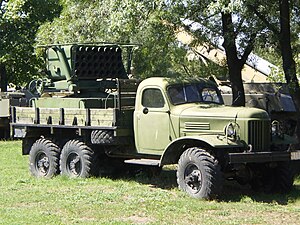
The 5 cm Pak 38 (L/60) was a German anti-tank gun of 50 mm calibre. It was developed in 1938 by Rheinmetall-Borsig AG as a successor to the 3.7 cm Pak 36, and was in turn followed by the 7.5 cm Pak 40. Note the unique curved gun-shield design which differs from most WWII anti-tank guns which have either one flat or two angled and one flat gun-shield plates for ease of manufacturing.

The BM-27 Uragan is a self-propelled 220 mm multiple rocket launcher designed in the Soviet Union to deliver cluster munitions. The system began its service with the Soviet Army in the late 1970s, and was its first spin and fin stabilized heavy multiple rocket launcher.

The BM-21 "Grad" is a self-propelled 122 mm multiple rocket launcher designed in the Soviet Union. The system and the M-21OF rocket were first developed in the early 1960s, and saw their first combat use in March 1969 during the Sino-Soviet border conflict. BM stands for boyevaya mashina, and the nickname grad means "hail". The complete system with the BM-21 launch vehicle and the M-21OF rocket is designated as the M-21 field-rocket system. The complete system is more commonly known as a Grad multiple rocket launcher system.
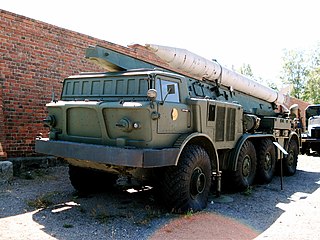
The 9K52 Luna-M is a Soviet short-range artillery rocket system which fires unguided and spin-stabilized 9M21 rockets. It was originally developed in the 1960s to provide divisional artillery support using tactical nuclear weapons but gradually modified for conventional use. The 9K52 was eventually succeeded by the OTR-21 Tochka.

The RM-70 multiple rocket launcher is a Czechoslovak Army version and heavier variant of the BM-21 Grad multiple rocket launcher, providing enhanced performance over its parent area-saturation rocket artillery system that was introduced in 1971.

The BM-14, is a Soviet-made 140mm multiple launch rocket system (MLRS), normally mounted on a truck.
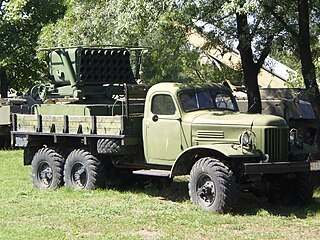
The ZIL-157 is a general-purpose 2+1⁄2-ton 6×6 truck, produced at the Lichachev plant in the Soviet Union from 1958 to 1977, when production was transferred to the Amur plant, since the Lichachev plant wanted to focus more on modern trucks, such as the ZIL-131 truck. Nevertheless, production of the ZIL-157 trucks continued even after the fall of the Soviet Union, but eventually ended in 1994.

The ZIS-151 was a general-purpose truck produced by the Soviet car manufacturer Automotive Factory No. 2 Zavod imeni Stalina in 1948–1958. In 1956, the factory was renamed to Zavod imeni Likhacheva, and new trucks were called ZIL-151 (ЗИЛ-151).

The M53/59 Praga is a Czechoslovak self-propelled anti-aircraft gun developed in the late 1950s. It consists of a heavily modified Praga V3S six-wheel drive truck chassis, armed with a twin 30 mm AA autocannon mounted on the rear for which the vehicle typically carries 900 rounds of ammunition, each gun being gravity fed from distinctive 50 round magazines. The vehicle has an armoured cabin.

Before 1989, Romania was among the top ten arms exporters in the world, however its arms industry declined considerably during the 1990s. Exports fell from roughly $1 billion before 1989 to about $43 million in 2006, and the number of employees also fell from 220,000 in 1990 to 20,000 in 2009. Sales to the Romanian Armed Forces have plunged after Romania's accession to NATO in 2004, as factories continue to produce Warsaw Pact-caliber weapons and ammunition, which are incompatible with their Western counterparts.

The 10.5 cm leFH 18/40 was a German light howitzer used in World War II.

The Light Artillery Rocket System is a series of West German vehicle mounted multi-barrel rocket launchers designed for rapid concentration of fire on designated targets. The rockets are of 110 mm caliber. The usual mounting was a lightly armoured Magirus or MAN 6x6 truck. 36 rockets were mounted in two clusters of 18. The weapon entered service in 1969 and was phased out by 1998 and replaced by the M270 Multiple Launch Rocket System.

The 10.5 cm Feldhaubitze 98/09, a short barreled (1625 mm) 105mm howitzer, also referred to as the 10.5 cm leichte Feldhaubitze 98/09, was used by the German Empire, Kingdom of Romania as well as the Ottoman Empire in World War I and after. It had a maximum range of 6,300 metres (20,700 ft).

The 85-mm divisional gun D-44 was a Soviet divisional 85-mm calibre field artillery gun used in the last action of World War II. It was designed as the replacement for the 76 mm divisional gun M1942 (ZiS-3). The gun is no longer in front-line service with the Russian Ground Forces, although some 200 of the Chinese Type 56 variant are still in service with the Pakistan Army. Wartime service included use by communist forces during the Vietnam War and by Arab forces during their conflicts with Israel.

The BM-24 is a multiple rocket launcher designed in the Soviet Union. It is capable of launching 240mm rockets from 12 launch tubes. Versions of the BM-24 have been mounted on the ZIS-151 6×6 Truck chassis and the AT-S tracked artillery tractor, forming the BM-24T from the latter. Production began out of Automotive Factory no. 2 in 1947 Moscow. Israel operated one battalion, consisting of vehicles captured from Egypt in the Six-Day War. The battalion took part in the Yom Kippur War and the 1982 Lebanon War.
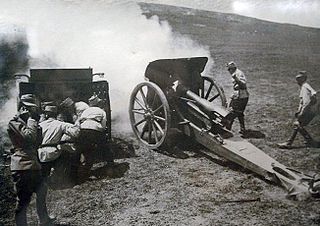
The Obuzierul Krupp, caliber 105 mm, model 1912 was a Romanian requested upgrade of the German 10.5 cm Feldhaubitze 98/09 howitzer used extensively during World War I. After two years of planning and experimentation by Romanian officers, the final design was approved and put into production by Krupp. The German aiming system was replaced with an improved Romanian system and the maximum range was increased to 6,500 meters, being superior to the 6,300 meters maximum range of its German counterpart. Maximum elevation was also increased from 40° to 60°. The first pieces started to arrive in Romania in 1912, and by the start of World War I thirty batteries were in service, their performance during the war being described as "flawless". However, wartime attrition was heavy and by the beginning of 1918, only 64 remained in service. They appear to have lingered in Romanian service into World War II. Guns captured by the Bulgarians appear to have been placed into service during World War I, although they seem to have been out of service by the outbreak of World War II.

Ștefan Burileanu was a Romanian officer, engineer, inventor, and academic who rose to the rank of major general in 1933.

The Walid is an Egyptian wheeled armored personnel carrier based on the BTR-40. It was built by the Kader Factory for Developed Industries. It entered production in 1960 and was first deployed by the Egyptian Army during the Six-Day War.
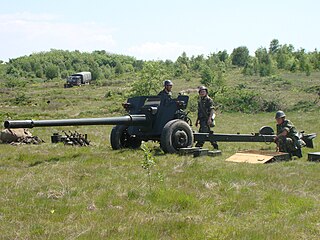
The A407 100mm anti-tank gun M1977 is a Romanian rifled 100-mm anti-tank gun which serves as the main towed anti-tank gun of the Romanian Land Forces from 1975 until present. Versions of the M1977 gun were installed on main battle tanks and ship turrets on river monitors.
